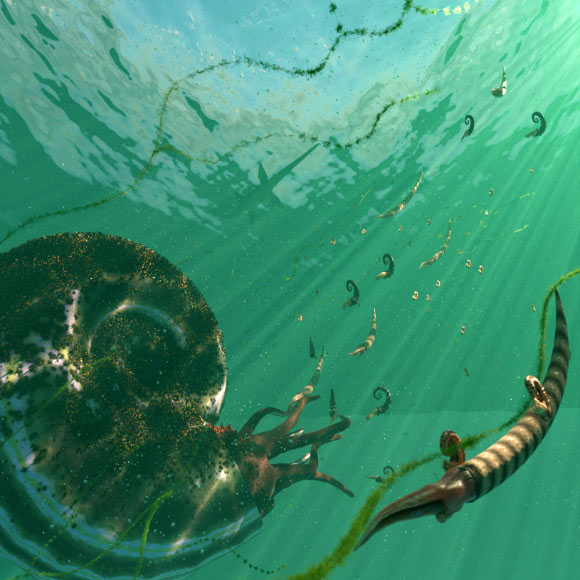A team of paleontologists from the United Kingdom and the United States has analyzed the fossil record of ammonites — marine mollusks often distinguished by their coiled shells — through the Late Cretaceous epoch (100.5 to 66 million years ago), characterized by some scientists as an interval of decline prior to their total extinction at the Cretaceous-Paleogene boundary. Their results show that instead of fizzling out ahead of their extinction, ammonoids were still going strong across the globe in the Late Cretaceous.
Ammonites basking under the Late Cretaceous Sun. Image credit: Callum Pursall.
Ammonoids flourished in Earth’s oceans for more than 350 million years until they died out during the same chance event that wiped out the dinosaurs 66 million years ago.
Some paleontologists have argued that their demise was inevitable and that the diversity of ammonites (the last major lineage of ammonoids) was decreasing long before they went extinct at the end of the Cretaceous period.
However, the new study shows that their fate was not set in stone; instead, the final chapter in ammonite evolutionary history is more complex.
“Understanding how and why biodiversity has changed through time is very challenging,” said Dr. Joseph Flannery-Sutherland, a paleontologist at the University of Birmingham and the University of Bristol.
“The fossil record tells us some of the story, but it is often an unreliable narrator.”
“Patterns of diversity can just reflect patterns of sampling, essentially where and when we have found new fossil species, rather than actual biological history.”
“Analyzing the existing Late Cretaceous ammonite fossil record as though it were the complete, global story is probably why previous researchers have thought they were in long-term ecological decline.”
To overcome this issue, Dr. Flannery-Sutherland and his colleagues assembled a new database of Late Cretaceous ammonite fossils to help fill in the sampling gaps in their record.
“We drew on museum collections to provide new sources of specimens rather than just relying on what had already been published,” said Cameron Crossan, a researcher at the University of Bristol.
“This way we could be sure that we were getting a more accurate picture of their biodiversity prior to their total extinction.”
Using their database, the paleontologists then analyzed how ammonite speciation and extinction rates varied in different parts of the globe.
If ammonites were in decline through the Late Cretaceous, then their extinction rates would have been generally higher than their speciation rates wherever the team looked.
What the researchers instead found was that the balance of speciation and extinction changed both through geological time and between different geographic regions.
“These differences in ammonoid diversification around the world are a crucial part of why their Late Cretaceous story has been misunderstood,” said Dr. James Witts, a paleontologist at the Natural History Museum, London.
“Their fossil record in parts of North America is very well sampled, but if you looked at this alone then you might think that they were struggling, while they were actually flourishing in other regions.”
“Their extinction really was a chance event and not an inevitable outcome.”
To find out what was responsible for the continued success of ammonites through the Late Cretaceous, the scientists looked at potential factors might have caused their diversity to change through time.
They were particularly interested in whether their speciation and extinction rates were driven mainly by environmental conditions like ocean temperature and sea level, or by biological processes like pressure from predators and competition between ammonites themselves.
“What we found was that the causes of ammonite speciation and extinction were as geographically varied as the rates themselves,” said Dr. Corinne Myers, a paleontologist at the University of New Mexico.
“You couldn’t just look at their total fossil record and say that their diversity was driven entirely by changing temperature, for example.”
“It was more complex than that and depended on where in the world they were living.”
The team’s results appear in the journal Nature Communications.
_____
J.T. Flannery-Sutherland et al. 2024. Late Cretaceous ammonoids show that drivers of diversification are regionally heterogeneous. Nat Commun 15, 5382; doi: 10.1038/s41467-024-49462-z
>>> Read full article>>>
Copyright for syndicated content belongs to the linked Source : Breaking Science News – https://www.sci.news/paleontology/ammonites-end-cretaceous-extinction-13056.html
